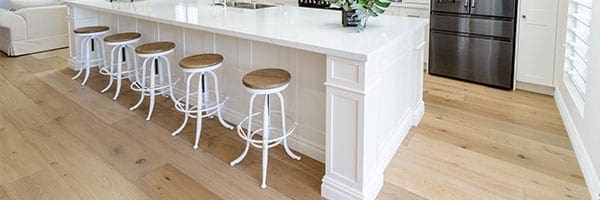When it comes to kitchen remodelling, deciding on the most suitable flooring generally comes down to a few core considerations.
Like many interior features of a home, what is right for your kitchen remodelling project might not always work for someone else. Although there are no set rules to remodelling kitchens, there are a few key elements to consider to ensure that you get a great result.
What are the flooring basics to consider when remodelling kitchens?
No one ever takes a one-size-fits-all approach to interior design and remodelling kitchens follows the same suit. In order to get the best result, it is important to consider the following criteria:
- your budget outlay and likely return on investment
- overall interior design and style of your home
- durability of the flooring product and its suitability for your needs
- cleaning and maintenance required
To cover off some of the more popular flooring solutions for kitchen remodelling projects, our team at Harrington Kitchens have compiled this handy flooring guide to help make light work of the decision process for you. This guide is based on the above four considerations.
Tiled floors
As one of the most popular flooring materials used in kitchen remodelling, tiles top our list of flooring options.
The pros of tiled floors
Compared to some of the other materials like hardwood timber and stone, tiles are generally more budget-friendly. Due to the extensive range available, tiles can easily be styled to suit any kitchen.
Tiles are often more durable and better wearing than hardwood timber and stone flooring. Although, most tiles will chip and break easily if hit with a heavy object, especially cheaper tiles. For this reason, we recommend you select a high-quality tile, such as porcelain, for a kitchen remodelling project if durability is important to you.
The cons of tiled floors
If a future buyer is not a fan of your tile selection, they can easily envisage ripping up the tiles which automatically detracts value from your kitchen. During kitchen remodelling, tiles should be installed correctly using a subfloor that won’t move or shift. A shifting subfloor will promote cracked tiles and grout.
Although the tiles themselves are easy to mop, the tile grout can get grimy and hard to clean, especially with oil splatters from cooking. Grout sealant should be applied as part of a kitchen remodelling project and refreshed periodically. Darker coloured grout can also help to mitigate this.
Hardwood flooring
Hardwood timber is another highly-popular selection we see in kitchen remodelling projects.
The pros of hardwood flooring
Hardwood tends to have it over tiling with return on investment for kitchen remodelling as buyers often attach a “premium” to natural wood flooring. When it comes time to sell, future buyers are less inclined to envisage the wooden flooring ripped up and started over, hence adding value to the initial outlay.
Hardwood can easily be styled to suit any kitchen – from Hamptons and shaker style to country or modern. Hardwood floors are also easily integrated into the rest of the home, particularly open-planned designs. If you are looking to re-style the remainder of your home in the future, this could be a consideration to take when remodelling your kitchen.
Hardwood is fairly easy to clean and low-maintenance.
The cons of hardwood flooring
Wooden flooring tends to dent, scratch and scuff, especially in high-traffic areas. Due to this, when choosing a hardwood material for a kitchen remodelling project, you are fairly limited. We recommend a textured look (or distressed finish) and a lighter colour that won’t show up as much dirt or damage as darker varieties.
Ash and oak are more hard-wearing than softer woods like pine, but these can add substantially to the kitchen remodelling price tag. Opt for a strong polyurethane finish to further enhance durability.
Wood does not mix well with water. If there is an unexpected leak, such as a faulty dishwasher connection or a leaky fridge, wood is highly susceptible to permanent water damage. Gaps in between hardwood flooring can trap dirt and small particles, as well as spilled water. Choosing engineered flooring with bevelled edges that butt up against each other can help to prevent this.
Over time, hardwood flooring will require a freshen up and re-polish.
Natural stone flooring
Natural stone flooring in a kitchen remodelling project can add extra sass and sophistication that tiles and timber simply cannot. For a premium finish you could consider materials like sandstone and granite.
The pros of natural stone flooring
Natural stone is premium and will add extra value to your kitchen remodelling project and overall home; without debate! Quality stone materials can offer a point of difference against a competitor property when it comes time to sell.
Quality stone is generally hardwearing, although marble and travertine are prone to scratches. It is very easy to clean, and keep clean.
The cons of natural stone flooring
If you are remodelling a kitchen on a tight budget, these materials probably won’t get a look-in. Natural stone is much higher on the price scale compared to its counterparts above. Natural stone is heavier and harder to work with than tiles, rendering it more expensive to lay and not a good project for DIY (unless you are a professional).
Stone floors require sealing which needs to be periodically renewed. Some slate can chip and crack easily and must be sealed correctly to avoid further damage.
Laminate flooring
Laminate has come a very long way since it was first introduced and a good quality laminate can imitate the look of wood or stone with a lesser price tag.
The pros of laminate flooring
Laminate is a great choice for a kitchen remodelling project if budget and return on investment are your main concerns. Cost effective to purchase, install and remove if your future buyer does not love it as much as you! These factors also make laminate the perfect option for kitchen remodelling in an investment property.
Top-end laminate can mimic the look of timber and stone which makes suiting any theme easy.
The cons of laminate flooring
Laminate quality will highly depend on how well it was manufactured. Steer clear of disasters waiting to happen and simply don’t purchase a laminate from the bargain bin.
Laminate is not water-tight and is also susceptible to leaks. The same care and attention should be given to laminate as is given to wooden flooring. In the event that the laminate is damaged, it is easier to be repaired than wood. For a kitchen remodelling project, always look for a laminate that is warrantied for high-moisture areas.
There are plenty of options when it comes to choosing the right flooring for your kitchen. The expert team at Harrington Kitchens can help you consider which flooring may best suit your new kitchen. Contact us now to discuss your dream kitchen remodelling project.


Recent Comments